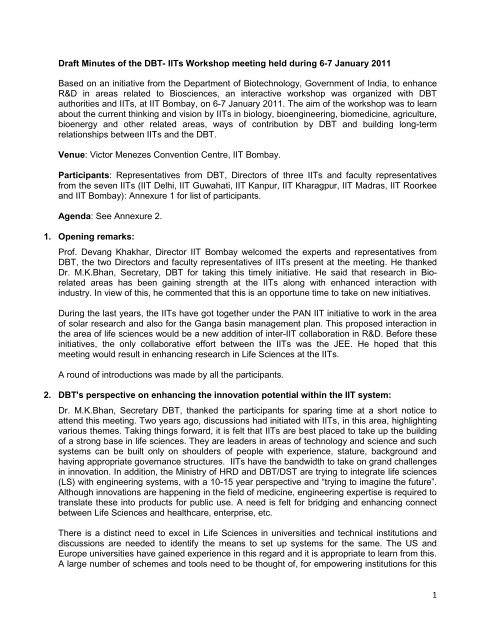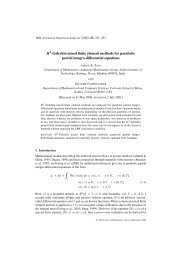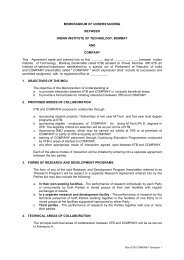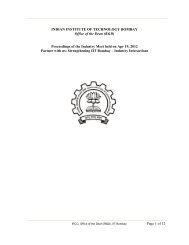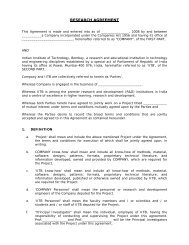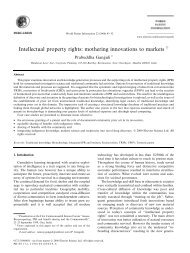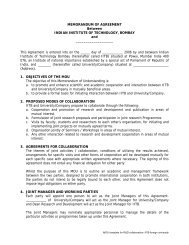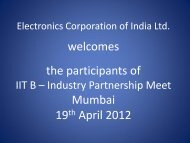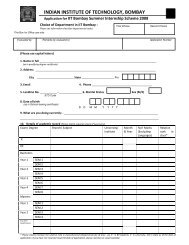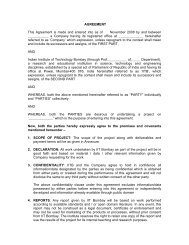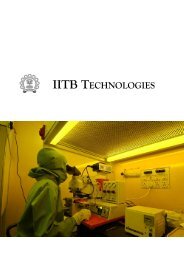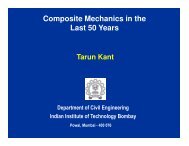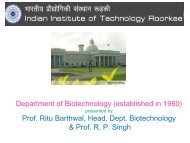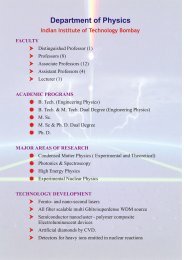1 Draft Minutes of the DBT- IITs Workshop meeting held ... - IRCC
1 Draft Minutes of the DBT- IITs Workshop meeting held ... - IRCC
1 Draft Minutes of the DBT- IITs Workshop meeting held ... - IRCC
Create successful ePaper yourself
Turn your PDF publications into a flip-book with our unique Google optimized e-Paper software.
<strong>Draft</strong> <strong>Minutes</strong> <strong>of</strong> <strong>the</strong> <strong>DBT</strong>- <strong>IITs</strong> <strong>Workshop</strong> <strong>meeting</strong> <strong>held</strong> during 6-7 January 2011<br />
Based on an initiative from <strong>the</strong> Department <strong>of</strong> Biotechnology, Government <strong>of</strong> India, to enhance<br />
R&D in areas related to Biosciences, an interactive workshop was organized with <strong>DBT</strong><br />
authorities and <strong>IITs</strong>, at IIT Bombay, on 6-7 January 2011. The aim <strong>of</strong> <strong>the</strong> workshop was to learn<br />
about <strong>the</strong> current thinking and vision by <strong>IITs</strong> in biology, bioengineering, biomedicine, agriculture,<br />
bioenergy and o<strong>the</strong>r related areas, ways <strong>of</strong> contribution by <strong>DBT</strong> and building long-term<br />
relationships between <strong>IITs</strong> and <strong>the</strong> <strong>DBT</strong>.<br />
Venue: Victor Menezes Convention Centre, IIT Bombay.<br />
Participants: Representatives from <strong>DBT</strong>, Directors <strong>of</strong> three <strong>IITs</strong> and faculty representatives<br />
from <strong>the</strong> seven <strong>IITs</strong> (IIT Delhi, IIT Guwahati, IIT Kanpur, IIT Kharagpur, IIT Madras, IIT Roorkee<br />
and IIT Bombay): Annexure 1 for list <strong>of</strong> participants.<br />
Agenda: See Annexure 2.<br />
1. Opening remarks:<br />
Pr<strong>of</strong>. Devang Khakhar, Director IIT Bombay welcomed <strong>the</strong> experts and representatives from<br />
<strong>DBT</strong>, <strong>the</strong> two Directors and faculty representatives <strong>of</strong> <strong>IITs</strong> present at <strong>the</strong> <strong>meeting</strong>. He thanked<br />
Dr. M.K.Bhan, Secretary, <strong>DBT</strong> for taking this timely initiative. He said that research in Biorelated<br />
areas has been gaining strength at <strong>the</strong> <strong>IITs</strong> along with enhanced interaction with<br />
industry. In view <strong>of</strong> this, he commented that this is an opportune time to take on new initiatives.<br />
During <strong>the</strong> last years, <strong>the</strong> <strong>IITs</strong> have got toge<strong>the</strong>r under <strong>the</strong> PAN IIT initiative to work in <strong>the</strong> area<br />
<strong>of</strong> solar research and also for <strong>the</strong> Ganga basin management plan. This proposed interaction in<br />
<strong>the</strong> area <strong>of</strong> life sciences would be a new addition <strong>of</strong> inter-IIT collaboration in R&D. Before <strong>the</strong>se<br />
initiatives, <strong>the</strong> only collaborative effort between <strong>the</strong> <strong>IITs</strong> was <strong>the</strong> JEE. He hoped that this<br />
<strong>meeting</strong> would result in enhancing research in Life Sciences at <strong>the</strong> <strong>IITs</strong>.<br />
A round <strong>of</strong> introductions was made by all <strong>the</strong> participants.<br />
2. <strong>DBT</strong>'s perspective on enhancing <strong>the</strong> innovation potential within <strong>the</strong> IIT system:<br />
Dr. M.K.Bhan, Secretary <strong>DBT</strong>, thanked <strong>the</strong> participants for sparing time at a short notice to<br />
attend this <strong>meeting</strong>. Two years ago, discussions had initiated with <strong>IITs</strong>, in this area, highlighting<br />
various <strong>the</strong>mes. Taking things forward, it is felt that <strong>IITs</strong> are best placed to take up <strong>the</strong> building<br />
<strong>of</strong> a strong base in life sciences. They are leaders in areas <strong>of</strong> technology and science and such<br />
systems can be built only on shoulders <strong>of</strong> people with experience, stature, background and<br />
having appropriate governance structures. <strong>IITs</strong> have <strong>the</strong> bandwidth to take on grand challenges<br />
in innovation. In addition, <strong>the</strong> Ministry <strong>of</strong> HRD and <strong>DBT</strong>/DST are trying to integrate life sciences<br />
(LS) with engineering systems, with a 10-15 year perspective and “trying to imagine <strong>the</strong> future”.<br />
Although innovations are happening in <strong>the</strong> field <strong>of</strong> medicine, engineering expertise is required to<br />
translate <strong>the</strong>se into products for public use. A need is felt for bridging and enhancing connect<br />
between Life Sciences and healthcare, enterprise, etc.<br />
There is a distinct need to excel in Life Sciences in universities and technical institutions and<br />
discussions are needed to identify <strong>the</strong> means to set up systems for <strong>the</strong> same. The US and<br />
Europe universities have gained experience in this regard and it is appropriate to learn from this.<br />
A large number <strong>of</strong> schemes and tools need to be thought <strong>of</strong>, for empowering institutions for this<br />
1
endeavour. This may include appropriate governance models and build global alliances for<br />
research and education e.g Innovative examples like Extramural centres.<br />
With this background, it is important to have a focussed discussion in <strong>the</strong> present workshop to<br />
identify what is needed with respect to people, depth <strong>of</strong> excellence, interdisciplinary research<br />
and systems and mechanisms to achieve <strong>the</strong>se goals.<br />
3. Building biology innovation in <strong>the</strong> engineering system: The global experience:<br />
Pr<strong>of</strong>. Mrigank Sur, MIT, USA shared his perspective from an US based experience. He also<br />
concurred that <strong>IITs</strong> are well placed for research in LS. Physicians especially in India are highly<br />
focussed on patient treatment and care as <strong>the</strong>ir prime aim and are not able to give time for<br />
research into disease causes and possible solutions. Hence it is <strong>the</strong> university systems which<br />
need to contribute towards this effort. In <strong>the</strong> early sixties, Vannevar Bush, Dean Engineering,<br />
MIT had realised that basic sciences generate problems for which engineers find solutions and<br />
are thus <strong>the</strong> drivers <strong>of</strong> engineering. As an example, an expert cell bacteriologist Salvador Luria<br />
was hired by MIT early on, to start a department <strong>of</strong> Biological Sciences and through his<br />
leadership, built a high research output team, boasting <strong>of</strong> 6 Nobel Laureates by 2000. Similar is<br />
<strong>the</strong> experience at Caltech which under <strong>the</strong> leadership <strong>of</strong> Max Delbrueck went to produce four<br />
Nobel laureates by <strong>the</strong> year 2000.<br />
The federal government felt it was important to be a partner in blending <strong>the</strong> two, for driving<br />
research and innovations. Hence research got a major thrust. India also needs to focus on such<br />
efforts to enable university systems, whcih are <strong>the</strong> true drivers <strong>of</strong> research.<br />
It is not essential to have a medical school for innovations to come through. Based on <strong>the</strong><br />
research efforts, <strong>the</strong> medical fraternity will seek interactions with <strong>the</strong> appropriate research<br />
institutions. It is important to have a long term vision and be willing to take risks. Many new<br />
areas have emerged through indirect insights in science. It is vital to have a strong leadership<br />
with vision, energy and enthusiasm along with full institutional support.<br />
MIT allows <strong>the</strong> flexibility for faculty to interact between different departments/disciplines and<br />
allow faculty to go to o<strong>the</strong>r places to learn and develop <strong>the</strong>ir research. Currently <strong>the</strong>re is lack <strong>of</strong><br />
funds in US and well trained Indian scientists are keen to return back. Hence it is an opportune<br />
time to attract experts to Indian institutes.<br />
In <strong>the</strong> discussion, many seconded <strong>the</strong> idea <strong>of</strong> focusing on interdisciplinary research<br />
programmes and <strong>the</strong> need for greater interface between science and engineering. Grand<br />
challenges should be presented and collaborative inter institutional research should be give<br />
impetus with appropriate funding by government.<br />
4. The Stanford-India Bio design initiative – <strong>DBT</strong> perspective:<br />
Dr. Alka Sharma, Jt. Director, <strong>DBT</strong>, shared <strong>the</strong> experience <strong>DBT</strong> had in setting up <strong>the</strong> Stanford<br />
India Biodesign programme as an inter institutional linkage between IIT Delhi, AIIMS and<br />
Stanford University, to promote medical technology innovation in India. It is a 2 year fellowship<br />
programme with six months to be spent in Stanford, to learn various aspects and adopt <strong>the</strong>se in<br />
<strong>the</strong> parent institution. The first batch (<strong>of</strong> 2008) developed three prototypes in <strong>the</strong> pulmono<br />
cardiac areas and industry such as Johnson and Johnson are funding $150,000 for fur<strong>the</strong>r work<br />
towards commercialization. The challenges faced were strong leadership, lowering <strong>of</strong> barrier<br />
between disciplines and promoting inter institutional interaction. A centre for Biodesign has now<br />
2
een set up in Faridabad (Translational Health Science and Technology Institute; THSTI) which<br />
feeds funds to various participating institutions without interfering in its activities. It was<br />
important to work out alternate hiring systems and have long term contract employees with<br />
attractive career paths.<br />
5. Presentations on "Ongoing IIT programmes in Bio-related areas and vision for future":<br />
<strong>IITs</strong> made presentations regarding <strong>the</strong> ongoing activities in research and education in <strong>the</strong> area<br />
<strong>of</strong> Bio-related areas. All <strong>the</strong> representatives acknowledged <strong>the</strong> initiative taken by <strong>DBT</strong> in this<br />
regard.<br />
i. IIT Delhi: (Annexure 3 for details <strong>of</strong> presentation)<br />
Pr<strong>of</strong>. Surendra Prasad, Director gave an initial brief, mentioning that <strong>the</strong> Centre for Biomedical<br />
Engineering was established in IITD as early as 1971, with interaction with AIIMS. O<strong>the</strong>r similar<br />
entities were added subsequently, with <strong>the</strong> most recent being <strong>the</strong> School <strong>of</strong> Biological Sciences<br />
in 2008, with support from <strong>the</strong> alumni. With <strong>the</strong>se resources, <strong>the</strong> institute has built capabilities<br />
for high end research in <strong>the</strong> interface <strong>of</strong> life sciences, biotechnology (BT) and engineering, with<br />
more than 50 faculty working in <strong>the</strong>se diverse bio related areas.<br />
Pr<strong>of</strong>. Saroj Mishra continued, commenting that different teaching programmes (B.Tech, M.Tech,<br />
DD, M.Sc., PhD) supported by MHRD and <strong>DBT</strong> are being pursued. Active research resulting in<br />
publications, patents and technology transfer/start-up companies were highlighted, along with<br />
future plans. A summary <strong>of</strong> areas <strong>of</strong> expertise was presented.<br />
A number <strong>of</strong> challenges were proposed based on internal discussions, available expertise and<br />
need. Director, IIT Delhi commented that core people with such expertise and leadership<br />
qualities were needed for sustaining <strong>the</strong>se areas <strong>of</strong> activity and specialized Chair pr<strong>of</strong>essorships<br />
need to be set up, <strong>of</strong>fering higher salaries and additional resources. This was being provided as<br />
top-up by <strong>the</strong> institute through its internal non-governmental resources, in addition to <strong>the</strong><br />
government salaries.<br />
ii. IIT Guwahati: (Annexure 4 for details <strong>of</strong> presentation)<br />
Pr<strong>of</strong>. Arun Goyal, Head, Department <strong>of</strong> Biotechnology, said that Director, IITG had regretted his<br />
inability to come for this <strong>meeting</strong> due to prior commitments. The Department <strong>of</strong> Biotechnology<br />
was set up in 2002 with UG and PhD programmes. M.Tech was added in 2008. There are 21<br />
faculty from diverse research streams with expertise ranging across engineering and life<br />
sciences. The students were getting good placements in various organisations both in India and<br />
abroad. Research grants were substantial, with recent sanction by <strong>DBT</strong> under <strong>the</strong> North Eastern<br />
Region (NER) - Twinning scheme. These had resulted in a large number <strong>of</strong> major equipment<br />
grants. The research highlights included different aspects <strong>of</strong> Genomics and Proteomics. Assam<br />
is a belt <strong>of</strong> rich biodiversity. Screening and preservation <strong>of</strong> this Biodiversity is an important need<br />
Future plans are to become recognized globally for excellence in research, facilities and quality<br />
<strong>of</strong> teaching, increase in industry interaction to develop products and processes for commercial<br />
use, enhance faculty strength and start additional specialised programmes in edical and Food<br />
biotechnology.<br />
Comments were raised regarding <strong>the</strong> need for a long term plan and implications <strong>of</strong> impact in<br />
future by a small number <strong>of</strong> faculty in <strong>the</strong> large number <strong>of</strong> disciplines mentioned. However, Pr<strong>of</strong>.<br />
Goyal mentioned that <strong>the</strong> Department is growing and faculty are converging to common<br />
3
esearch goals. Hence <strong>the</strong> proposed programme would help in enhancing <strong>the</strong> research.<br />
However, appropriate governance structure would need to be addressed.<br />
Pr<strong>of</strong>. Sur commented that a having a specialised programme in Biotechnology at <strong>the</strong> UG level is<br />
undesirable (too early in <strong>the</strong> academic training <strong>of</strong> students) and especially so if <strong>the</strong> placement<br />
scenario is not encouraging. At MIT, UGs do courses in life sciences as part <strong>of</strong> <strong>the</strong> curriculum<br />
along with courses in physics, chemistry and ma<strong>the</strong>matics. Industry was not positive about <strong>the</strong><br />
UG personnel graduating in BT since <strong>the</strong>ir knowledge and practical capabilities are limited. Also<br />
critical mass is very important for enhanced research. Link ups with neighbouring management<br />
institutions (e.g.IIM Kolkata) should be considered to help take up innovations fur<strong>the</strong>r.<br />
iii. IIT Kanpur: (Annexure 5 for details <strong>of</strong> presentation)<br />
Pr<strong>of</strong>. R.Sankararamkrishnan communicated <strong>the</strong> regret from IITK Director for his last minute<br />
inability to attend this <strong>meeting</strong>. The Bioscience and Bioengineering Department (BSBE) has<br />
been set up in 2001 as a multidisciplinary initiative, focusing on three broad areas <strong>of</strong> Genetics,<br />
Genomics & Developmental Biology, Structural & Computational Biology and Bioengineering.<br />
The department has good synergy with o<strong>the</strong>r departments <strong>of</strong> <strong>the</strong> institute and also with o<strong>the</strong>r<br />
national and international universities, organisations and industries. Research in Bio-related<br />
areas is being pursued vigorously, resulting in a good number <strong>of</strong> publications, patents and<br />
grants and awards. The future plans were to start new education programmes for innovation in<br />
Biology, along with research encompassing IIT Post doc positions, animal house facility and<br />
newer interface with o<strong>the</strong>r engineering departments. The research vision at <strong>the</strong> institute is to<br />
take up fundamental research to address industrial applications in <strong>the</strong> areas <strong>of</strong> health,<br />
agriculture, pharmaceuticals, diagnosis and products.<br />
The challenge was to motivate <strong>the</strong> JEE toppers to go into basic research. For this, people have<br />
to be nurtured to become star leaders in <strong>the</strong> area <strong>of</strong> Biology and thus create teams and attract<br />
young minds to this area. It may be sufficient to focus on one area <strong>of</strong> application.<br />
iv. IIT Kharagpur: (Annexure 6 for details <strong>of</strong> presentation)<br />
Pr<strong>of</strong>. D.Acharya, Director gave his opening remarks, mentioning that Bioscience started in <strong>the</strong><br />
institute in 1951 in agricultural science-plant biology. With time, a number <strong>of</strong> initiatives have<br />
been taken. One <strong>of</strong> <strong>the</strong> recent ones was collaboration with UC Berkeley in Medical science and<br />
technology. Due to its location, it is easier to link up with foreign universities, although<br />
challenges had to be met. The institute was trying to have academic programmes <strong>of</strong> B.Tech<br />
M.Tech and Ph.D seamlessly across <strong>the</strong> various disciplines. It was in <strong>the</strong> process <strong>of</strong> setting up<br />
innovative „medical education‟ with a different curriculum and syllabus. The focus is on research<br />
in <strong>the</strong> medical field and how to bring down <strong>the</strong> diagnosis cost, remote diagnostics, telemedicine<br />
and healthcare support. Collaboration was envisaged with <strong>the</strong> University <strong>of</strong> California San Diego<br />
and Johns Hopkins University, USA. Clearance from health ministry was through. He felt <strong>the</strong><br />
need to create state <strong>of</strong> <strong>the</strong> art facilities in <strong>the</strong> area <strong>of</strong> bioscience and commented that <strong>the</strong><br />
institute made a fundamental course in biology mandatory for all UG students.<br />
Pr<strong>of</strong>. P.K.Dutta continued, outlining <strong>the</strong> research in area <strong>of</strong> life sciences cutting across large<br />
disciplines <strong>of</strong> science and engineering. M.Tech programmes started in 1986 and currently, <strong>the</strong><br />
academic programmes include B.Tech, M.Tech, DD and Ph.D in Biotechnology and<br />
Biochemical Engineering. Future goal is to initiate an MSc-Ph.D programme and to introduce<br />
remedial courses to fill gaps for better understanding. Funding from <strong>DBT</strong> was requested for<br />
supporting this.<br />
4
Dr. Bhan commented that an M.Sc-Ph.D programme should produce an expert in drug<br />
discovery and efforts should be made to produce a scientist out <strong>of</strong> a MBBS graduate and<br />
establish a good career path. Learning could be made from <strong>the</strong> NCBS experience. It was felt<br />
that research centres / societies created out <strong>of</strong> hospitals are <strong>the</strong> only places where research in<br />
<strong>the</strong> medical field is addressed, e.g KEM, Mumbai, CMC Vellore and St. Johns Hospital,<br />
Bangalore. Main hospitals do not have this possibility. However <strong>the</strong> system in <strong>the</strong> US is<br />
different.<br />
v. IIT Madras: (Annexure 7 for details <strong>of</strong> presentation)<br />
Pr<strong>of</strong>. K.Krishnaiah, Dean Academic Research gave brief history and outline <strong>of</strong> <strong>the</strong> current status<br />
at <strong>the</strong> institute. The biomedical engineering was started in 1971 in <strong>the</strong> Department <strong>of</strong> Applied<br />
Mechanics with M.Tech, MS and Ph.D programmes. Subsequently various o<strong>the</strong>r academic<br />
entities were added and currently a Biomedical Design research centre has been established<br />
with funding from <strong>DBT</strong>, with an aim to produce medical devices. Along with <strong>the</strong> normal UG and<br />
PG academic programmes, M.Tech in Clinical Engineering and Ph.D in Biomedical Devices and<br />
Technology are being <strong>of</strong>fered as multi-institutional programmes. The placement <strong>of</strong> students was<br />
good and also for those wishing to pursue higher studies. Future plans are to convert all UG<br />
programmes to DD in Biological Engineering, starting from 2012. The research thrust included<br />
Bioprocess Engineering, Computational Biology, Chemical Biology and Medical Biotechnology.<br />
Research funding, publications, patents, collaborations, faculty / student honors & awards and<br />
start ups were shown to give an insight to <strong>the</strong> research capability at <strong>the</strong> institute.<br />
The future plans include working closely with Indian Biotechnology industry to transfer<br />
technologies, creating a centre <strong>of</strong> excellence in Bioprocess and Metabolic Engineering and<br />
carrying out translational research in <strong>the</strong> area <strong>of</strong> medical Biotechnology, green chemistry and<br />
computational biology. Interdisciplinary research supported by <strong>DBT</strong> is being undertaken in <strong>the</strong><br />
area <strong>of</strong> Parkinson‟s disease. The Biomedical design programme has a focus on DD, M.Sc and<br />
Ph.D programmes. A proposal was submitted to <strong>DBT</strong> for setting up a translational centre for<br />
Medical Device Design and Development.<br />
vi. IIT Roorkee: (Annexure 8 for details <strong>of</strong> presentation)<br />
Dr. R.Barthwal mentioned that <strong>the</strong> Department <strong>of</strong> Biotechnology at IIT Roorkee was <strong>the</strong> oldest,<br />
set up in 1980. The M.Sc programme is supported by <strong>DBT</strong> and <strong>the</strong> B.Tech programme started<br />
in 2005. The students were found excellent and well placed. The capabilities at <strong>the</strong> institute<br />
were highlighted through publications, patents, award and honours and student placements<br />
along with <strong>the</strong> different research projects undertaken. Major equipment facilities were available<br />
and <strong>the</strong> research focus encompassed various areas in structural biology & drug discovery and<br />
Microbial technology, bioprocess technology and nanobiotechnology.<br />
vii. IIT Bombay: (Annexure 9 for details <strong>of</strong> presentation)<br />
Pr<strong>of</strong>. Dulal Panda highlighted that 15% <strong>of</strong> <strong>the</strong> institute faculty are actively involved in bio related<br />
research in a wide spectrum <strong>of</strong> areas, ranging from basic to applied to translational research.<br />
The major strength is a strong teaching and research programme in biosciences and<br />
bioengineering through active collaboration. Some <strong>of</strong> <strong>the</strong> research accomplishments were<br />
shown, including publications, patents, student data, collaborations & network and <strong>the</strong> recent<br />
initiative <strong>of</strong> setting up <strong>of</strong> <strong>the</strong> Wadhwani research centre for Biosciences and Bioengineering and<br />
for setting up a healthcare initiative to develop a network hub for <strong>the</strong> Western region. Academic<br />
programmes related to UG and PG also included minors and electives. The future goals are to<br />
catalyse integration <strong>of</strong> <strong>the</strong> life sciences work into engineering disciplines, translate technologies<br />
5
into products, accelerate societal benefits from <strong>the</strong> research and healthcare entrepreneurship.<br />
Academic interdisciplinary programmes in biology and outreach programmes were envisaged.<br />
The R&D directions are to establish IITB as a world leader in healthcare research. Support was<br />
requested from <strong>DBT</strong> for various aspects.<br />
It was commented that setting up <strong>of</strong> animal house is a major exercise and if possible this should<br />
be outsourced to commercial entities. Differing opinions were given on this issue.<br />
6. Breakout Sessions to discuss how to enhance interaction between <strong>IITs</strong> and <strong>DBT</strong><br />
The four break out session were converged into two, namely a) Interdisciplinary Research &<br />
Development / Governance structure (Annexure 10) and b) Education & outreach, Capacity<br />
building - People, infrastructure, inter-institutional linkages and governance structures<br />
(Annexure 11). Dr. Bhan commented that some key words be given for possible schemes /<br />
proposals. Members were requested to have 45 minutes <strong>of</strong> discussion followed by 5 minute<br />
presentation.<br />
a. Interdisciplinary Research & Development / Governance structure (Annexure 10)<br />
Summary <strong>of</strong> discussions:<br />
Interests need to be identified, keeping in mind <strong>the</strong> capabilities available for <strong>the</strong> same.<br />
Use our strengths in strong basic sciences and engineering to solve grand challenge<br />
problems, innovative solutions<br />
Areas proposed: Medical diagnostics (nanotech), Structure based drug design and<br />
diagnostic molecules, Medical devices and technologies, Microbial biotechnology,<br />
Bioprocess development, “Omics”, systems and computational biology, Drug delivery.<br />
In each area, a grand challenge problem to be identified; fur<strong>the</strong>r, a white paper is needed, for<br />
which more <strong>meeting</strong>s are to be had between <strong>IITs</strong>; <strong>DBT</strong> could help to have experts from<br />
industry / translational fields at <strong>the</strong>se <strong>meeting</strong>s, with not more than 10-15 stakeholders.<br />
Planning grant from <strong>DBT</strong> to move ahead<br />
Project leader to be identified<br />
Enhance interdisciplinary research and identify industry and hospitals for interaction<br />
b. Education & outreach, Capacity building - People, infrastructure, inter-institutional<br />
linkages and governance structures (Annexure 11)<br />
Some comments:<br />
The academic programmes should be defined well, have industry linkage and envisage<br />
student exchange across <strong>IITs</strong>.<br />
Post doc positions should be streng<strong>the</strong>ned through specific funding and enable <strong>the</strong>m to<br />
mentor UGs and PGs.<br />
6
Value addition to education is very important<br />
Industry complain <strong>of</strong> lack <strong>of</strong> relevant exposure for <strong>the</strong> new recruits, hence have an element <strong>of</strong><br />
bio design in <strong>the</strong> teaching programmes<br />
Give students project exposure<br />
Glue grants / virtual networked grad schools<br />
Involvement <strong>of</strong> <strong>IITs</strong> for teacher training- outreach for better outputs<br />
Indian Bioengineering User Programme (IBUP) cells to be set up in all <strong>IITs</strong><br />
Animal facility for all <strong>IITs</strong> to use<br />
Summary:<br />
(Education:<br />
Undergraduate Lab upgradation – <strong>IITs</strong> to come up with a common plan<br />
Benchmarking Biotech education<br />
Internships for students between <strong>IITs</strong> and o<strong>the</strong>r institutions such as biomedical research<br />
institutions<br />
Fellowship grants in <strong>the</strong> 5 th year similar to Biodesign<br />
Virtual centers and glue grants between grad schools<br />
Outreach:<br />
Indian Bioengineering Users Program (IBUP) cells to be set up in all IIT-s. Students from<br />
o<strong>the</strong>r colleges/Universities to be mentored for project ideas<br />
Infrastructure:<br />
Animal House – outsource and ask for special funds<br />
Infrastructure to be included in <strong>the</strong> R&D and Education plan)<br />
7
Day 2: 7 January 2011:<br />
7. Summary <strong>of</strong> <strong>the</strong> break-out sessions <strong>of</strong> previous day:<br />
Pr<strong>of</strong>. S.B.Noronha, IITB presented <strong>the</strong> summary <strong>of</strong> <strong>the</strong> discussions <strong>held</strong> in <strong>the</strong> two breakout<br />
sessions (Annexure 10 and 11, also given above).<br />
Some comments:<br />
Dr. S.Natesh, <strong>DBT</strong> said that each IIT should come up with specifics <strong>of</strong> <strong>the</strong>ir requirements and<br />
provide a detailed document with a governance plan and point <strong>of</strong> contact for fur<strong>the</strong>r action.<br />
He would discuss with Dr. Bhan and come out with a detailed plan on way ahead.<br />
Governance should allow student internships outside <strong>of</strong> <strong>IITs</strong> system e.g AIIMS etc.,<br />
preferably during summer.<br />
Medical research internships may need Medical Council <strong>of</strong> India (MCI) clearance and take<br />
time and hence one should look at feasibility in <strong>the</strong> near future<br />
Teacher mentoring programme should be included<br />
A case for specific support in 1-2 areas in each IIT may be desirable. Presentations show a<br />
vast expanse <strong>of</strong> areas, but each IIT should aim to become leaders in 1-2 areas, which will<br />
help in raising appropriate funding. Although this may mean o<strong>the</strong>r areas <strong>of</strong> research<br />
continue, in order to contribute towards this growth, it is important to debate on this. Teams<br />
could be built around a few star researchers <strong>of</strong> an institute or a specific <strong>the</strong>me <strong>of</strong> interest<br />
could be decided and a team built around it, e.g IISc had built expertise in Biophysics by<br />
design, through getting leaders and building teams around <strong>the</strong>m and now this area is known<br />
globally- a peak within a broad plateau.<br />
It may be easier to identify few areas but not just one; enabling mechanisms are provided to<br />
support researchers wanting to work in specific areas but as an institute, it may not be easy.<br />
8. Feedback on Interaction with <strong>DBT</strong>:<br />
IIT Delhi:<br />
Their experience with <strong>DBT</strong> regarding funding has been pleasant and healthy. Animal house<br />
support and post doc initiatives would be very welcome. In addition, continued support from<br />
<strong>DBT</strong> for areas identified and for experimental projects (in <strong>the</strong> form <strong>of</strong> bridge grants), beyond<br />
three / five years is desirable in order to sustain <strong>the</strong> activities initiated.<br />
The supercomputing facility at IIT Delhi had been set up based on brainstorming with more than<br />
100 faculty regarding <strong>the</strong> need for such facility with access to all. <strong>DBT</strong> had adopted this facility<br />
for 5 years since 2008.<br />
8
IIT Guwahati:<br />
They have had similar good experience with <strong>DBT</strong> which has funded research projects and also<br />
<strong>the</strong> M.Tech programme at <strong>the</strong> institute. In addition <strong>the</strong> cell for North Eastern Region (NER)<br />
support was also welcome. There have been some delays in sanctions and acknowledgement<br />
<strong>of</strong> proposals submitted and <strong>the</strong>ir status would be appreciated. Also project presentation / review<br />
through video mode may obviate <strong>the</strong> need for travel and save time.<br />
IIT Kanpur:<br />
Although <strong>DBT</strong> has funded education programmes, which is acknowledged, it would be desirable<br />
to give such special grants to <strong>IITs</strong> separately, without grouping with all o<strong>the</strong>r institutions, to<br />
retain identity. The need for continued support after <strong>the</strong> first few years was reiterated and<br />
commented that <strong>the</strong> normal funding had no issues.<br />
IIT Kharagpur:<br />
Although <strong>DBT</strong> has been supported engineering programme since 1986, <strong>the</strong> equipment grant<br />
had been reduced and only recently Rs.30 lakhs grant had been sanctioned for <strong>the</strong> same. Since<br />
a major overhaul was due, additional funding would be appreciated. Also faster communication<br />
regarding projects funding status would be appreciated. The project review was felt to be very<br />
good with high level <strong>of</strong> technical content. Again <strong>the</strong> need for bridge grant was mentioned and<br />
also whe<strong>the</strong>r fast track grants could be provided to explore an idea in order to seed big projects<br />
later.<br />
The institute will have a task force to look into <strong>the</strong> specific programmes for special support by<br />
<strong>DBT</strong>.<br />
IIT Madras:<br />
The overall experience with <strong>DBT</strong> was good with no issues in <strong>the</strong> technical aspects. Some<br />
administration related comments included-<br />
Stringent provision <strong>of</strong> overheads (<strong>of</strong> only Rs.1 lakh per year)<br />
AMC @5% <strong>of</strong> cost for big equipment needed<br />
If specific posts are approved and <strong>the</strong> institute gets a different level manpower, flexibility<br />
needed to address <strong>the</strong>se<br />
Freedom/ability to carry forward <strong>of</strong> funds<br />
Delay in release <strong>of</strong> funds<br />
Review process to be formally relooked at – create a team for faster turnarounds (e.g.<br />
along <strong>the</strong> lines <strong>of</strong> BIRAP model)<br />
IIT Roorkee: (Annexure 12 as handwritten document)<br />
They have had limited experience with <strong>DBT</strong> for research funding, with <strong>the</strong> exception <strong>of</strong> support<br />
to <strong>the</strong> MSc programme. Few research projects are currently funded by <strong>DBT</strong>; however <strong>the</strong><br />
institute plans to converge and take up new initiatives for funding by <strong>DBT</strong>.<br />
Support to JRFs (5 per year) and post docs (5 per year) should be given directly to <strong>the</strong> <strong>IITs</strong> with<br />
an aim to achieve excellence in identified field <strong>of</strong> research. Support from <strong>DBT</strong> is requested for<br />
9
teaching and research equipment, consumables, AMC and also to enhance interaction with<br />
industries, in addition to support for PG programme as a separate set for <strong>IITs</strong>.<br />
IIT Bombay: (Annexure 13)<br />
The M.Sc support from <strong>DBT</strong> is sustained and continued. Reiterating o<strong>the</strong>r comments it was said<br />
that, acknowledging <strong>the</strong> receipt <strong>of</strong> submitted proposals, intimating <strong>the</strong> review status <strong>of</strong><br />
submissions and timely decisions regarding project funding would be appreciated. Online<br />
systems such as that existing for workshop support would be very good. Timely release <strong>of</strong> grant<br />
after sanction would help in appropriate / effective expenditure. Regarding IP ownership, would<br />
prefer retaining ownership with institute in order to take decision related to patenting, technology<br />
license etc. Flexibility regarding exclusive / non exclusive models would be desirable since<br />
substantial investment by some companies may make <strong>the</strong> excusive model more attractive.<br />
Pr<strong>of</strong>. B.Ravi gave an example <strong>of</strong> a successful multi institution network project in <strong>the</strong> area <strong>of</strong><br />
Orthopaedic CAD/CAM was funded by <strong>the</strong> Principal Scientific Advisor, GoI.<br />
Sanction within 4 months <strong>of</strong> proposal submission<br />
Higher salaries than usual norms allowed<br />
Equipment purchase flexibility, re-allocation <strong>of</strong> funds within framework<br />
Excellent review<br />
IPR given to <strong>the</strong> institute;<br />
Resulted in 3 patents, s<strong>of</strong>tware and clinical trials stage and quality manufacturing system all<br />
within <strong>the</strong> three years <strong>of</strong> work<br />
It would be desirable to be able to replicate such systems and processes for undertaking<br />
effective research.<br />
All <strong>IITs</strong> wished a maintenance grant but it may be appropriate if <strong>the</strong> institutes take up such<br />
responsibility. This may be possible if a business plan is included in <strong>the</strong> proposal, make good<br />
use <strong>of</strong> <strong>the</strong> equipment generated and charge users. Mechanisms need to be created to generate<br />
such funding and also ensure optimal use <strong>of</strong> <strong>the</strong> high end equipment. One <strong>of</strong> <strong>the</strong> <strong>IITs</strong> has a<br />
model <strong>of</strong> supporting AMC and manpower for equipment which are made accessible to all.<br />
Sometimes researchers did not wish to share <strong>the</strong> facilities due to <strong>the</strong>ir own need. Any<br />
equipment above Rs.50 lakhs value should be treated as an institute facility and possible<br />
mechanisms such as formation <strong>of</strong> not-for-pr<strong>of</strong>it companies to run and maintain <strong>the</strong> same will be<br />
useful. Enhanced usage and maintenance would both be taken care <strong>of</strong> though this model.<br />
<strong>DBT</strong> may recommend to MHRD to build in AMC support for such maintenance, alternatively <strong>the</strong><br />
overheads could be enhanced to take care <strong>of</strong> this requirement.<br />
9. Proposed new initiatives and support requirement from <strong>DBT</strong>:<br />
IIT Delhi:<br />
Proposed challenges and areas <strong>of</strong> partnership: (please see presentation in Annexure 3)<br />
1. Affordable diagnostics / devices<br />
10
2. Design, Process Optimization & Scale up <strong>of</strong> Biological Processes (Microbial, plant & animal<br />
cell fermentation…)<br />
3. Genomics / Proteomics & Diseases Target Identification & Database Creation<br />
(Neurodegenarative / diabetes etc.)<br />
4. Novel Genes & Enzymes for Food Bioprocesses (Detoxification & Value Addition)<br />
5. Bioenergy<br />
Animal house access is available at NII, AIIMS and BLS level 1, 2 and 3 labs are available from<br />
IITD funding.<br />
With an initiative already running with Stanford University, it is hoped that <strong>DBT</strong> would be able to<br />
fund a M.Tech. programme in Biomedical Engineering and also work towards giving students <strong>of</strong><br />
<strong>the</strong> Biodesign centre a degree.<br />
IIT Guwahati:<br />
IITG has expertise and proposed focus in Medical diagnostics, Microbial biotechnology, Drug<br />
discovery, computational biology in <strong>the</strong> next ten years.<br />
Support from <strong>DBT</strong>- Scholarship for UG, UG lab upgradation, support for BSL level 2, 3 facilities<br />
and animal house facilities (it was felt that due to its location, IITG could set up <strong>the</strong> animal house<br />
facilities as a as a nodal agency to cater to o<strong>the</strong>r institutes in <strong>the</strong> region)<br />
IIT Kanpur:<br />
A Centre for Bio innovation was being proposed by IIT Kanpur to create an engine to run <strong>the</strong> multi<br />
faceted Bioactivity in <strong>the</strong> institute. This enabling centre will have appropriate education and<br />
technology thrust combined with business / industry linkages and interdisciplinary research in<br />
health science and research. One focus would be on osteo arthritis and various aspects <strong>of</strong><br />
research would connect <strong>the</strong> 12 faculty working in diverse areas. There is a need to collaborate<br />
with o<strong>the</strong>r institutes also.<br />
IIT Kharagpur: (Annexure 14)<br />
Integrated approaches towards discovery <strong>of</strong> new targets for <strong>the</strong>rapeutics 2020<br />
Design <strong>of</strong> micr<strong>of</strong>luidic platforms for early detection <strong>of</strong> cancer<br />
Development <strong>of</strong> green microbial technologies for nutraceuticals and pharmaceuticals<br />
IIT Madras:<br />
Areas <strong>of</strong> thrust include Bioprocess engineering, Chemical Biology, Computational Biology and<br />
Medical Biotechnology.<br />
The future R&D plans include<br />
To work closely with Indian Biotechnology industry to transfer some <strong>of</strong> <strong>the</strong> technologies<br />
developed (Example: Hyaluronic acid)<br />
11
To create a Centre <strong>of</strong> Excellence in Bioprocess Engineering and Metabolic Engineering<br />
To carry out translational research in <strong>the</strong> area <strong>of</strong> medical biotechnology, green chemistry and<br />
computational biology<br />
Support from <strong>DBT</strong> was sought for <strong>the</strong> teaching programmes.<br />
IIT Roorkee: (Annexure 12)<br />
Two research groups having critical mass for future research and were identified namely,<br />
Structure based drug designing and microbial Technology with proposed research project on<br />
Biomolecules <strong>of</strong> <strong>the</strong>rapeutic interest for anticancer related drugs.<br />
Support from <strong>DBT</strong>: (Please see information given under IIT Roorkee above)<br />
IIT Bombay:<br />
Three months ago, based on a brainstorming between 35 faculty <strong>of</strong> <strong>the</strong> institute working in bio<br />
related areas, a new initiative in healthcare R&D was taken and a white paper has been given to<br />
<strong>DBT</strong> for IITB to become <strong>the</strong> Western region hub for this initiative, interfacing between o<strong>the</strong>r<br />
organisations and hospitals. A workshop is planned to be <strong>held</strong> on 29 th January to identify<br />
stakeholders and ways to catalyse integration <strong>of</strong> research in life sciences. This is expected to be<br />
in a consortium mode with a hope to have effective societal impact.<br />
<strong>DBT</strong> support is hoped in <strong>the</strong> form <strong>of</strong> funding for research, post docs, etc to facilitate <strong>the</strong> creation<br />
<strong>of</strong> <strong>the</strong> CoE in Healthcare.<br />
10. Comments and Discussion:<br />
Work in <strong>the</strong> area <strong>of</strong> structure based drug design may not get funding from industry and this is<br />
one aspect where <strong>DBT</strong> funding would be useful. In this regard, <strong>the</strong> setting up <strong>of</strong> a synchrotron<br />
for use by Chemical Biologists was discussed. It was commented that currently <strong>the</strong> experiments<br />
were done abroad in France, Grenoble, and Saskatoon Canada. <strong>DBT</strong> had an agreement with<br />
Grenoble Synchrotron facility and PSA, DST with Saskatoon facility.<br />
An indigenous synchrotron facility would be a very important asset. Beam lines specific to each<br />
need could be built by individual groups but <strong>the</strong> facility can be outsources on a turnkey basis to<br />
an external organisation. Our researchers should be involved more in <strong>the</strong> science aspect.<br />
The issue <strong>of</strong> animal house was also discussed. It was felt that certain work may be able to<br />
manage with an external animal house and but certain studies e.g, cell biology need a<br />
dedicated Animal house in <strong>the</strong> institute. Dr. Ramaswamy, NCBS mentioned that a workshop<br />
was being <strong>held</strong> in Bangalore on 7-9 March 2011, where a well known builder <strong>of</strong> Animal house<br />
facility (JAX from USA) was giving lectures. Anyone interested is welcome to attend this<br />
<strong>meeting</strong> to raise relevant queries regarding <strong>the</strong> same.<br />
Based on <strong>the</strong> specific needs identified, appropriate animal house requirements should be<br />
finalised. Focus should be on idea generation and routine issues should be outsourced as much<br />
as possible.<br />
Devices and diagnostics was an important area to focus on since 87% is currently exported as<br />
per a statistics report. Healthcare is largely unaffordable and <strong>the</strong> initiative proposed by IITB would<br />
12
e an important activity to focus on. The initiative should be in <strong>the</strong> form <strong>of</strong> a virtual centre cutting<br />
across all <strong>IITs</strong> and in a consortium mode. Link with IIMs could be envisaged for translation into<br />
products.<br />
IIT Delhi put forth a thought to look at <strong>the</strong> „Genome card‟ <strong>of</strong> <strong>the</strong> 1.1 billion Indians as a concerted<br />
effort across all <strong>the</strong> 15 <strong>IITs</strong>. This was felt to be a brilliant very large scale project idea. India could<br />
take <strong>the</strong> lead which o<strong>the</strong>rs could emulate. Substantial amount <strong>of</strong> efforts <strong>of</strong> biologists, maths,<br />
computational experts would be needed and this can be <strong>the</strong> „Chandrayaan” <strong>of</strong> <strong>DBT</strong>.<br />
A network should be established across <strong>IITs</strong> in education and research in Biotechnology and<br />
periodic annual <strong>meeting</strong>s should be <strong>held</strong> to review activities with <strong>DBT</strong> providing <strong>the</strong> glue.<br />
Ano<strong>the</strong>r aspect was <strong>the</strong> regulatory approvals and current system was not adequate. <strong>DBT</strong> is in<br />
<strong>the</strong> process <strong>of</strong> getting cabinet approvals for <strong>the</strong> same and systems should be in place shortly.<br />
11. Closing remarks by Dr. S.Natesh, <strong>DBT</strong>:<br />
The <strong>DBT</strong> team had come to <strong>IITs</strong> because <strong>of</strong> <strong>the</strong> excellence available and <strong>the</strong> organisation was<br />
planning activities for <strong>the</strong> 12 th plan. A number <strong>of</strong> activities had been taken up as promised<br />
earlier in <strong>the</strong> „Biotechnology strategy and action plan‟ earlier and <strong>the</strong> regulatory systems should<br />
also be in place soon. Since <strong>IITs</strong> are also planning to get in Life Science research in a big way,<br />
it was appropriate to get toge<strong>the</strong>r, come to a consensus and work toge<strong>the</strong>r to put an action plan.<br />
The comments made about <strong>DBT</strong> processes are known and efforts on to address / improve<br />
<strong>the</strong>m. Trials are on for online project proposal submission. Reforms in competitive grants are<br />
being reviewed and will be resolved soon.<br />
Three clusters are being set up in Bangalore (Basic plant science research, silk biotechnology<br />
and material science research with NCBS, CCAMP, and Agricultural universities involvement)<br />
Faridabad (Health related focus with THSTI, NII and o<strong>the</strong>rs with a biodesign programme thrust)<br />
and Mohali (focus on agriculture, food biotechnology and nutrition, with participation <strong>of</strong> IISER,<br />
ISB, DST) to focus on life sciences and <strong>the</strong> aim is to connect all <strong>the</strong> clusters to have a mega<br />
innovation centre in <strong>the</strong> next 10 years.<br />
The summary <strong>of</strong> all <strong>the</strong> presentations and discussion would be put up on a website for all to<br />
review. The governance need to be discussed more and should include mechanisms for<br />
internships, research mobility, industry liaison, technology transfer services, incubation, etc.<br />
Each IIT should discuss internally on what it would like to be famous for through hard brain<br />
storming to come up with a focus. An IIT-<strong>DBT</strong> platform will be set up to meet periodically and<br />
add new ideas to this platform. The first <strong>meeting</strong> may be <strong>held</strong> in IIT Delhi with a smaller group to<br />
review <strong>the</strong> discussions <strong>held</strong> and initiate a way forward.<br />
He thanked all <strong>the</strong> participants and IITB for organising <strong>the</strong> workshop.<br />
12. Vote <strong>of</strong> thanks:<br />
The Dean (R&D) <strong>of</strong> IIT Bombay thanked Dr. Bhan, Dr. Natesh and <strong>DBT</strong> for taking this initiative<br />
and being <strong>the</strong> glue to bring <strong>the</strong> <strong>IITs</strong> researchers toge<strong>the</strong>r to discuss future work in <strong>the</strong> important<br />
area <strong>of</strong> life sciences. He thanked all <strong>the</strong> experts for giving <strong>the</strong>ir valuable inputs. Special thanks<br />
were were due to <strong>the</strong> <strong>IRCC</strong> staff including Ms. Rusheeda, Ms. Vanishree, Mr. Arumugam, Dr.<br />
13
Krishna Lala, Dr. Padma Satish and <strong>the</strong> o<strong>the</strong>r staff for all <strong>the</strong> background work, logistics and <strong>the</strong><br />
arrangements for <strong>the</strong> <strong>meeting</strong>. He thanked all <strong>the</strong> participants in <strong>the</strong> <strong>meeting</strong> and hoped that this<br />
is <strong>the</strong> beginning <strong>of</strong> new direction in integrating Life Sciences in engineering and will help solve<br />
many problems in healthcare, energy, water, etc. in <strong>the</strong> country with support from <strong>DBT</strong>.<br />
The Annexures may be seen in <strong>the</strong> web link given:<br />
http://www.ircc.iitb.ac.in/<strong>IRCC</strong>-Webpage/2010<strong>DBT</strong>01.jsp<br />
14


